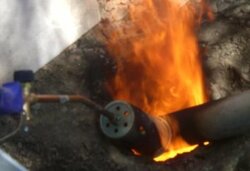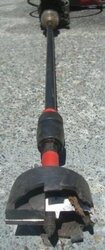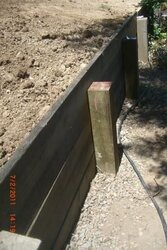I've got a 100' retaining wall made up of 2"x12"x12' horizontal members and 6"x6" vertical. The vertical members of a 12' section rotted away and failed this winter under all of the rains.
Digging new cement holes for off set vertical members would have been a real pain so I decided to use the old cement cores and somehow take out the old rotted wood plug in the hole of each.
First I started with a 1" auger drill bit. Too small. I couldn't chip away any of the wood around the hole with my breaker bar since it was wet and spongy and the hole too small. Spent 3 hours trying.
Then I decided to try to burn it out with harbor freight propane tourch wand. 4 hours of burning took me down 3 inches. Still no luck.
Then I tried to sink an 12"x3/4" lag screw into the wood and pull it out with a 8 ton hydraulic jack pushing up on 4 feet of a 6"x6" chained to the end of the screw embedded in the wood plug. It stripped the screw right out.
By this time, I was already out $80 buying tools which didn't do the job.
After some research I bought a 2 9/16" wood auger and put it on an 18" chuck extension (seen below). 10 minutes later I had cored the wood plug with a hole big enough for me to break out even the wet wood with my bar. Job done in 30 minutes.
I post this solution only because I spent so much time figuring it out that others may want to know about it. I feel like a dunce for not knowing about this solution in the first place.
Once the holes where clear of wood, new posts just dropped in. The rest of the retaining wall was up on 30 minutes and back fill done in 20.
If I had to dig new holes for new posts it would have taken many hours and I would have ended up with a lot of extra dirt to dispose of. Now that I have the technology to reuse the old cement shafts, I save time (I can drill out and remove the old wood in about 30 minutes) and money (not having to buy 200 lb of post mix for every new hole) and I don't have to dispose of many yards of dirt/clay.
BTW, after drilling the hole in the wooden plug, I use a shop vac to suck out the wood dust. It also does a good job of getting out any rocks which may have fallen into the hole. If you hit a rock with that bit - game over and its time to swap in a new blade. That was an important feature of that bit - the fact that new blades and center tap screws can be added if they wear out.
Digging new cement holes for off set vertical members would have been a real pain so I decided to use the old cement cores and somehow take out the old rotted wood plug in the hole of each.
First I started with a 1" auger drill bit. Too small. I couldn't chip away any of the wood around the hole with my breaker bar since it was wet and spongy and the hole too small. Spent 3 hours trying.
Then I decided to try to burn it out with harbor freight propane tourch wand. 4 hours of burning took me down 3 inches. Still no luck.
Then I tried to sink an 12"x3/4" lag screw into the wood and pull it out with a 8 ton hydraulic jack pushing up on 4 feet of a 6"x6" chained to the end of the screw embedded in the wood plug. It stripped the screw right out.
By this time, I was already out $80 buying tools which didn't do the job.
After some research I bought a 2 9/16" wood auger and put it on an 18" chuck extension (seen below). 10 minutes later I had cored the wood plug with a hole big enough for me to break out even the wet wood with my bar. Job done in 30 minutes.
I post this solution only because I spent so much time figuring it out that others may want to know about it. I feel like a dunce for not knowing about this solution in the first place.
Once the holes where clear of wood, new posts just dropped in. The rest of the retaining wall was up on 30 minutes and back fill done in 20.
If I had to dig new holes for new posts it would have taken many hours and I would have ended up with a lot of extra dirt to dispose of. Now that I have the technology to reuse the old cement shafts, I save time (I can drill out and remove the old wood in about 30 minutes) and money (not having to buy 200 lb of post mix for every new hole) and I don't have to dispose of many yards of dirt/clay.
BTW, after drilling the hole in the wooden plug, I use a shop vac to suck out the wood dust. It also does a good job of getting out any rocks which may have fallen into the hole. If you hit a rock with that bit - game over and its time to swap in a new blade. That was an important feature of that bit - the fact that new blades and center tap screws can be added if they wear out.





